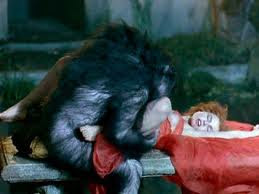Note: this essay originally included greater length discussion of the individual segments of this film, its aesthetic (including digital vs. celluloid), and its theme of "place", but I felt the need to streamline its focus to a single topic, at the cost of a balanced review. Since writing I have discovered pages that cover these areas in greater detail: please see here, here, and here (where I swiped the picture) for respective treatments of each of these aspects of Ruhr.
If you've ever tried meditating you'll know what I'm talking about. You sit in a comfortable position and at first everything is fine. But it doesn't take long for the mind to reveal itself as a raging tempest, a chaosphere of thoughts/etc. When you finally calm it down to the point where you can actually focus on keeping your body still, you see just how unstill it actually is. The amount of things you notice can be incredible, but it makes sense: all that once-stormy mental energy needs something to do, so it will work with what you give it. Your body wants to shift, rearrange its position. Your fingers tend to fiddle. Your eyelids flicker at animal speed. When you can get all that locked down, you realize that the whole time your tongue's been partying and you didn't even know it. Point is, there's a lot going on in your mind, and when focus is forced there's a lot you're able to notice about what's going on outside as well.
Perhaps that's also the point of movies like Ruhr, James Benning's most recent avant garde offering. Ruhr consists of seven segments shot in the Ruhr district of Germany. It is divided into two parts, the first of which is six scenes, each a static shot with some kind of observable repeating process (for instance: machines at a steel plant; planes passing by through the trees; a group of people going from standing to kneeling in a Muslim prayer ceremony). The second is a single hour-long shot of a building that periodically creates an explosion of billowing sepia smoke that's absolutely stunning. Active since the 1970s, Benning has made a great many acclaimed films based on this idea of the extremely long static shot.
Andy Warhol charted similar territory in the early '60s, but his films were so long (over 8 hours for Empire, a single static shot of a building in slow-motion) as to be considered objectively "unwatchable". It seems he had points about art and cinema at heart rather than the experience of the viewer. This type of shot, meant to call attention to the difference between "seeing" and "watching", has been used pretty frequently in what used to be called "arthouse" films since the '70s (Godard and Herzog both come to mind), and can be seen recently in the work of Michael Haneke, whose films usually include one or two of these lengthy repetition shots each.
This type of shot is easily-obtained: repeated processes are everywhere in the world. Then: would just any of these be beautiful or interesting? Well, these shots are often not beautiful, nor interesting at first, so the answer could be "yes". Forcing yourself to watch anything that lasts a long time with consistent non-action may generate the same (or very similar) effects. Could just anyone do it, then? In the plastic arts this question was made irrelevant after the advent of abstract expressionism in American painting, making it safe for formally-simple experiments of the "conceptual", "minimal", "postmodern" persuasion. But pointing a video camera at something is much easier even than silkscreening, and though Benning carefully planned the scenes, invisibly edited the footage, and meticulously mixed the soundtrack, it's not clear that the lack of these things would have resulted in a much different experience. I always wonder what the artists would say to this kind of thing, but you can't go to them- after all, they're the ones posing the questions in the first place. The fact that it continues to bring up questions is the reason that, after so long, the James Benning "thing" continues to be experimental.
The most obvious thing that staring at almost-nothing will do is is to readjust the bar for what constitutes a "thing", the premise of John Cage's 4:33. As an example, let's discuss the first scene of Ruhr. The shot is of a road in a tunnel. At random intervals a car drives through. At first you begin to anticipate the next car with a kind of relish. Because of their regularity, though, and your elevation of the scenery you've been staring at to a higher level of interest, the passing cars become part of that scenery, of equal importance as the static details. So when a biker comes into the frame, it's such an exciting surprise I heard many audience members giggling. The scene ends with a dead leaf dragging itself (even now I endow the leaf with a will of its own, when of course it was the unperceivable wind) loudly across the street . This is the most interesting thing in the whole scene, due to a process of preparation that constituted the scene itself. I was even compelled to bring it up with my companions after the movie ("remember the part when the leaf moved?" I asked them. They did.).
As with early attempts at meditation mentioned above, there are a variety of places your mind is taken (whether by the film or by itself is a question with no clear answer). I was continually reminded of the limits of my vision. As much as I wanted to, it was impossible to watch the whole screen at once. We are limited to a narrow focus, and when you really start playing with it, you realize how little your peripheral vision gives you. Ruhr provides ample opportunity for such experiments, time for your eyes to alternately dart around or stare at one thing as long as you can then move on systematically to another. Either way you go, you'll find that you can only watch one thing at a time.
I also kept coming back to the differences between my experience as a viewer of this film in the theater vs. if I were actually there, watching in life the things depicted on the screen. We've all had experiences sitting somewhere idly and noticing something subtly interesting, which we watch for a long time either dazedly or with fascination. I came to the conlcusion that while that experience would be far more pleasant, the fact that I could change perspective, stop looking, or become distracted at any time means I would probably cut short my experience as soon as I was bored. The stasis, confinement, and fact-of-framing that the cinema experience provides forces the mind to a level of intellectual rigor that you just probably wouldn't have gotten to on your own. If you find yourself totally without a thought, you can always fall back on "why?", something you would not likely ask the trees in a forest.
That brings us to another major question (or rather a set of them): is it worth it? It was for me; despite half the theater walking out pell-mell up 'til nearly the end, I'd certainly recommend it. Well, having gone through the fire of extreme boredom and come out cleansed, so to speak, do I feel the need to do it again? Of course not. So would I? In other words, having seen one film of this variety, and learned what I did from it, would I subject myself to the same (or very similar) experience of a different film of this type? Yes I would, if only to see just how different the experience is (to say nothing of the striking beauty a few of the shots provided). Should people, should James Benning, keep making these movies that offer the same (or very similar) experiences, despite a proliferation of them already? Until all the questions are anwered...
One more thing to note is the fact that Benning usually works with 16mm film, but Ruhr was shot in HD. The two movies I've seen at the New York Film Festival are both the first digital works of major directors whose careers span decades (the other is Godard's Film Socialisme; see below). Despite how obvious video's inevitable replacing of film already is, this fact still seems significant to me.











